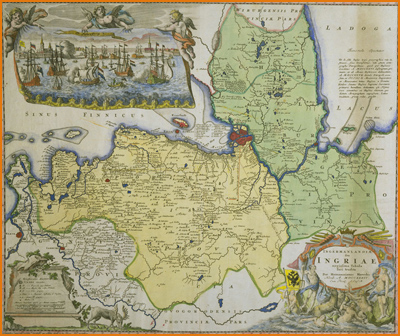|
 St.
Petersburg, 1718: An Early German Depiction St.
Petersburg, 1718: An Early German Depiction
|
 |
| Photographic
Services & Permissions |
 |
Ingermanlandiae seu Ingriae Novissima Tabula [The Most Up-to-date Record
of Ingermanland or Ingria]
Nuremberg: Heirs of Johann Baptist Homann, 1734
NYPL, Slavic and Baltic Division, Bates-Pantuhoff Collection
Ingria, a disputed territory for centuries, was annexed to Russia by Peter the
Great in 1721 at the conclusion of the Great Northern War with Sweden. The region
formed a protective land barrier around his new city of St. Petersburg, which
we see in the tapestry at upper left, helpfully displayed by thoughtful putti. Warlike
ships are on parade in this view. At the lower right, various sea nymphs pay
homage to Neptune, God of the Sea.
 |
|
|
|














